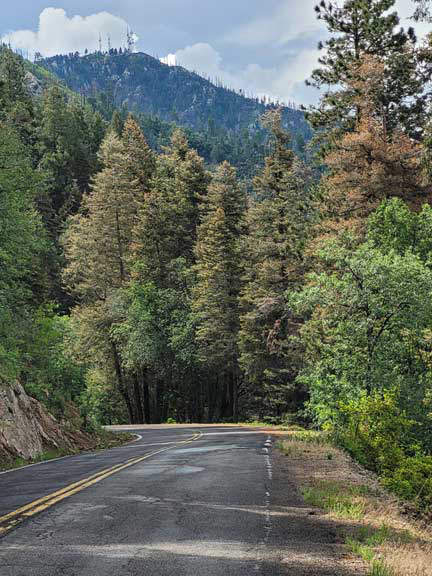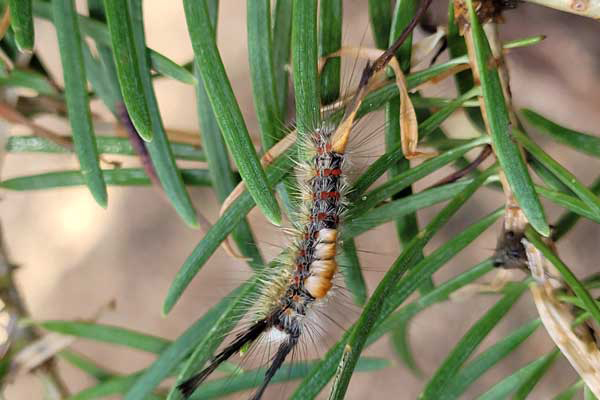Contributed article
SAFFORD — A sudden and severe defoliation (damage or loss of needles) event was reported in the Safford Ranger District, Coronado Nation Forest on Mount Graham in late June of 2022.
Forest Service entomologists with the Arizona Zone, Forest Health Protection program confirmed the agent responsible for the damage is a native insect, the Douglas-fir tussock moth, Orgyia pseudotsugae.
The outbreak is concentrated in lower mixed conifer forests along State Route 366, Swift Trail Scenic Highway, from Turkey Flat recreation and residential area up to Ladybug Saddle. Symptoms of the damage include defoliation caused by feeding caterpillars and needle discoloration from healthy green foliage to a brownish-red hue as the partially consumed vegetation begins to dry. Damage is highly visible along the scenic highway and in several recreation areas including along the Turkey Flat Trail.
Trees with light to moderate defoliation often survive a single defoliation event. However, branch dieback and tree mortality may occur when caterpillars eat more than 80 percent of the needles. These defoliated trees also become less vigorous and more susceptible to bark beetle attacks. As the outbreak begins, the damage is concentrated on new foliage and thus most apparent in treetops and in the outer branches. As they grow, caterpillars consume new and old needles from early to mid-summer.
Damage symptoms will worsen as caterpillars mature and consume more vegetation. From mid to late summer the caterpillars construct cocoons generally on the underside of host vegetation or on branches, tree trunks, and even on patio furniture during outbreaks. Adults emerge from cocoons and mate during the fall. After mating, the flightless female will lay an egg mass on top of the cocoon from which she emerged. Egg masses will overwinter and hatch the following spring as new vegetation emerges from host trees. One generation occurs per year and outbreaks may continue for three to four years.

Natural enemies including a virus generally reduce populations once they become abundant.
Suppression efforts may be needed in high-use recreation areas to reduce the population and impacts to vegetation or critical habitat. In addition to impacts on tree health, we anticipate high numbers of caterpillars to occur in these areas potentially posing a health and safety hazard to visitors due to contact with the urticating or irritating hairs of the caterpillars leading to tussockosis.
Older caterpillars are about 1-inch long and are covered in long hairs with noticeable tufts of hairs behind the head, along the body, and at the rear. People and animals can develop an itchy rash or other allergic reactions from exposure to the irritating hairs, called “tussockosis.” Itching is the most common complaint, but adverse health effects can include rashes with welts or blisters, watery eyes, runny nose, cough, and less commonly, shortness of breath, wheezing, and chest tightness.
People should avoid areas with heavily defoliated trees, caterpillars, cocoons, and egg masses. Workers in these areas should wear long sleeves to reduce contact with caterpillars. It is also recommended to wash hands and any exposed skin with soap and water, change clothing and take a cool shower after being exposed to areas with heavy infestation.
Forest Health Protection will continue to monitor the extent and severity of the damage and the insect populations during 2022. Fall assessments will inform the need for further management.
If there are additional questions or concerns, about damage occurring on the Coronado National Forest please contact Amanda Grady, Forest Entomologist at amanda.grady@usda.gov, or Joel McMillin, Arizona Zone Leader for Forest Health Protection at Joel.McMillin@usda.gov. Private landowners and affected residences should contact Aly McAlexander, Forest Health Specialist with the Arizona Department of Forestry and Fire Management at amcalexander@dffm.az.gov.
For any additional questions feel free to contact the Coronado National Forest at Mailroom_R3_Coronado@usda.gov. For the most current updates about the Coronado National Forest, please follow on Facebook at https://www.facebook.com/CoronadoNF and Twitter at https://twitter.com/CoronadoNF.









